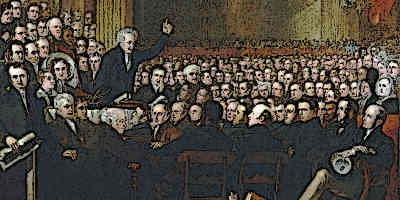Civil Rights Act of 1964
Discover the Civil Rights Act of 1964 and the End of Racial Segregation
History of American Slavery
The origins of slavery in America can be traced back to the year 1619
Slavery and the Slave Trade
Slavery in American is closely tied in with the Colonial Period of American History
The Civil Rights Movement
The Civil Rights Movement was launched in response to discrimination against African Americans
Slavery in the Colonies
In 1619 a Dutch ship sold African slaves to the Englishmen close to Jamestown, Virginia. As a result of this, slavery spread quickly spread throughout the colonies. Initially, the slaves were regarded as indentured servants and were released after a specific period.
However, eventually, this system was replaced by the race-based slavery system and people of color became the ultimate target. In 1641 Massachusetts declared slavery legal.
Other colonies passed various laws that passed the legacy of slavery down to the future generations and even declared imported non-Christian servants slaves for life. Slaves were given some legal rights, and they created their own lifestyle in the quarters as well.

African Americans and Religion
By the 1800s, a small portion of African slaves had joined the Christian churches. The free blacks in the Northern areas constructed their own churches while in the Southern regions, the blacks used to sit in the white church’s gallery. During African American history, the black church played a huge role.
It served as a neighborhood center where the blacks could honor their African heritage. The black church was the only place free from the white man’s influence. It was also a place of learning, as well. Both the free and enslaved blacks were taught here.
Cotton Industry in the South and Slavery
After the American Revolution, the South faced a severe economic crisis. The area where tobacco was grown had become completely exhausted. Along with this, rice and indigo industries failed as well. As a result of this, the value of slaves began to drop. During this period, the mechanics of weaving and spinning were introduced.
It brought a revolution in the textile industry. However, removing seeds from cotton fibers was a difficult task. In 1793, Eli Whitney introduced the Cotton Gin. It was a mechanical device that removed the seeds proficiently.
The South shifted to the cotton industry. The rise of the cotton industry once again led to an increase in the demand for Black slaves and is an important part of African American history.
The Rise of the Abolitionist Movement
The Abolitionist Movement was started by black slaves who wanted to liberate themselves. Quakers played a role in it as well. They criticized slavers on moral and religious grounds.
Although the American Revolution revitalized the Abolitionist movement, by 1780, it had declined. In 1793 Congress passed the Fugitive Slave Act, and the laws regarding slavery became stricter.
In response to this, many radical Abolitionists emerged. William Lloyd Garrison played a massive role in this movement. In 1831, he launched the Liberator and was one of the most radical anti-slavery activists.
During the 1780s, many antislavery northerners had started helping the slaves escape from the South to the North via the Underground Railroad.
The Dred Scott Case – African American history
Dred Scott was an important figure in African American history, he was a slave who, along with his master, moved from Missouri to Illinois where slavery was prohibited. Scott filed a case for his freedom. The case went to the Supreme Court, which declared in 1857 that slaves were not citizens and had no legal rights.
This decision was heavily criticized by both the abolitionists and the Republican party.
The Supreme court also declared that the Missouri Compromise was unconstitutional. According to the court, slaves were property and they were protected under the Fifth Amendment.
Congress had no authority to deprive the slave owners or slave traders of their property rights. After the introduction of the Civil Rights Act of 1865, this verdict was overturned.
American Civil War and African Americans
In 1861, the American Civil War took place. Eleven southern states separated from the Union and founded the Confederate States of America. Many lives were lost during this conflict.
President Lincoln tried to preserve the Union, and after achieving victory at Antietam in September, he announced the primary Emancipation Proclamation. Lincoln was an important figure in African American history.
On January 1st, 1863, it officially became law and instantly changed the status of more than 3 million slaves in the Confederacy to freedmen. Lincoln justified his actions as a wartime measure; however, he did not enforce the proclamation on the towns that were allied with the Union.
By June 1865, the Union Army gained complete control over the Confederacy and had liberated all of the selected slaves. Over 200,000 free blacks joined the Union Army/ Navy and earned the right to full citizenship.
African Americans during Reconstruction
After the Union’s victory in the civil war, the Reconstruction period started. During this period, blacks made a lot of progress. They were given the right to vote, elected into Congress, and also appointed as sheriffs.
African Americans also constructed their own churches, towns, and businesses. Blacks settled in Mississippi because it had a lot of underdeveloped areas.
By the 19th century, a vast majority of farmers who owned land in Mississippi’s bottomland areas were blacks. In 1870, Hiram Revere became the first African American Congressman.
Other black politicians from South Carolina, Georgia, Alabama, and Mississippi joined him as well. They provided support to the republicans and tried to improve the lives of the black people.
The Jim Crow Laws
The Jim Crows Laws were enforced from 1876 to 1965. As per these laws, blacks were not allowed to attend the same schools or use the same facilities as whites. On May 18, 1896, the Supreme Court issued a verdict that approved segregation as long as equal facilities were provided to both groups.
This led to the formation of separate but equal doctrine, which became the basis of the future segregation laws.
The Civil Rights Movement
Although the Civil War had ended slavery, discrimination against the blacks remained. By the 20th century, the blacks had become tired of the constant violence and prejudice. They, along with various white people, launched the Civil rights Movement. Its purpose was to gain equal rights for the blacks.
The movements started in the 1950/the 60s and continued for the next two decades. It culminated in equal rights being accorded to the African Americans across the United States, both in theory and practice.






